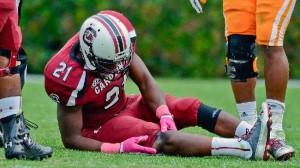One of the most competitive sports out there is football. On Sunday nights, fans gather around big screens and dive into finger foods, beers, and the best smack talking around. But with this sport comes a range of different football injuries, some are temporary and some are life threatening.
Football has the highest risk of injury compared to other sports
The cheerful, competitive spirit can suddenly turn to silence and worry with the falling of a player. These football injuries can affect the rest of the game or even worse… the season. These injuries can be emotional at times for the player, team, and family. But what exactly are these injuries?
Here is a breakdown of the most common football injuries that players go through.
The Most Common Football Injuries
- ACL injuries – The anterior cruciate ligament in the knee can become damaged or torn when a player is impacted from the front or rear.
- MCL injuries – Injury to the medial collateral ligament in the knee is also very common because it occurs when the knee is impacted from the side.
- Torn meniscus – When a player rotates their body while a foot stays planted, the knee can twist, causing the meniscus to tear.
- Ankle sprains and strains – Perhaps the most common injury in all sports, ankles are susceptible to soft tissue damage when pivoting, changing direction, or putting too much pressure on the joint.
- Muscle contusions – A strong impact to a large muscle, usually in the thigh, can cause a contusion. This is basically a large, deep bruise that can impair muscle function.
- Torn hamstrings – Bursts of speed can cause the hamstrings to tear if the player is not conditioned or properly warmed up.
- Shoulder tendinitis – Frequent throwing can cause overuse injuries like shoulder tendinitis from repetitive motions.
- Shoulder separation or dislocation – A direct blow below the shoulder can cause a separation of the acromioclavicular joint, while a dislocation occurs when the head of the humerus detaches from the scapula.
Treatment of football injuries
As stated before football is a high risk sport. One of the reasons for this elevated risk is that football is a high-impact sport. Tackling, blocking, and other physical interactions between players can result in contusions, concussions, and other common injuries.
Another reason football injuries are so common is simply the nature of the game. Players must frequently pivot and change direction, increasing the likelihood of injuries to the joints and other tissues. Sudden bursts of speed can cause muscle damage if the player is not properly warmed up. Which is a key factor to prevent injuries!
The treatment protocol for these football injuries varies and can range from basic RICE: Rest, Ice, Compression, Elevation.
to surgery with several options in between. For all of these injuries, RICE can be improved with active cold and compression therapies to help speed up the healing process for injuries. Cold compression therapy can also be used after surgery to help speed up the recovery process.



